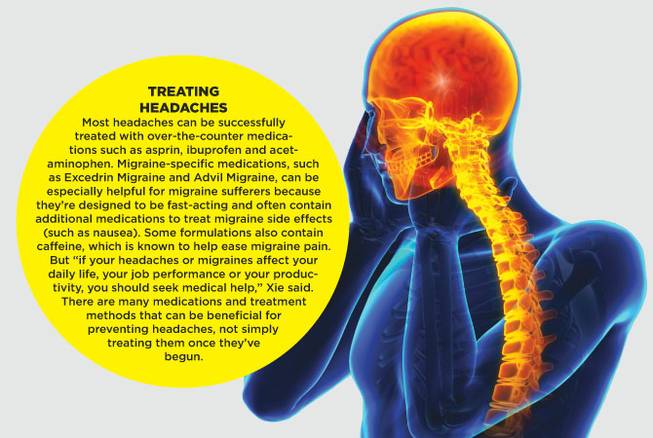
Monday, March 13, 2017 | 2 a.m.
The World Health Organization (WHO) reports that headaches are among the most common nervous system disorders and estimates that half of adults worldwide have had at least one headache in the past year, and 1 in 20 adults experiences a headache daily or nearly every day.
There are many different types of headaches and many potential causes and symptoms. “Almost any time you have pain in the head, it’s a headache. Migraines are one common type, but their etiology, or cause, is different from the typical headache,” said Kevin Xie, MD, neurologist at Nevada Neurosciences Institute at Sunrise Hospital and Medical Center.
While headaches and headache disorders are common and affect many people’s daily lives, they’re also often underestimated and undertreated, according to WHO.
°°°
Types of headache
A headache disorder is characterized by having multiple headaches throughout a period of days, weeks, months or a year, depending on the severity of the disorder.
There are four common types of headaches:
1. Tension-type headache: Tension-type headaches are the most common, caused by stress and sometimes associated with musculoskeletal issues in the neck.
Chronic tension headaches can be debilitating, similar to chronic migraines, and the two often are confused for each other during diagnosis.
Symptoms: Dull, aching pain in the head; tightness or pressure in your forehead, sides and/or back of your head; and muscle tenderness in your scalp, neck and shoulders.
2. Migraine: “Generally speaking, there are three types of migraines: migraine with aura, migraine without aura and others such as hemiplegic migraines, which can cause one side of the body to experience weakness,” Xie said.
Migraines are nearly twice as common in women as they are in men because of hormonal influences. Many women who experience chronic migraines report their menstrual cycle as having a direct effect on the presentation of the migraine.
“The exact cause of migraines is unknown, but we know there are brain neuron changes during the migraine,” Xie said. Migraine triggers can include allergies, bright or flashing lights, exhaustion, emotional stress, hormonal changes and dehydration.
Symptoms: Migraines often cause more severe symptoms than the typical headache, such as an “aura” that can affect the patient’s vision, and nausea and vomiting. Other symptoms include throbbing/pulsating pain, light and sound sensitivity, blurred vision, lightheadedness and/or dizziness and pain on one side of the body.
3. Cluster headache: Cluster headaches are not as common as migraines or tension-type headaches, but they are still considered a primary headache disorder. They’re characterized by brief but extremely severe headaches that usually occur several times throughout the day.
Sinus headaches are common cluster headaches.
Symptoms: Usually focused on one side of the face or eye, and can cause tearing and redness, a drooping eyelid and/or a runny nose.
4. Medication-overuse headache: Medication-overuse headaches are caused by patients taking too much medication to treat a headache. This causes a headache cycle, as the patient continues to worsen the headache by overtreating it, and continues to overtreat it because the headache has worsened.
These headaches are often at their worst when the patient wakes up.
°°°
Treating headaches
Most headaches can be successfully treated with over-the-counter medications such as asprin, ibuprofen and acetaminophen.
Migraine-specific medications, such as Excedrin Migraine and Advil Migraine, can be especially helpful for migraine sufferers because they’re designed to be fast-acting and often contain additional medications to treat migraine side effects (such as nausea). Some formulations also contain caffeine, which is known to help ease migraine pain.
But “if your headaches or migraines affect your daily life, your job performance or your productivity, you should seek medical help,” Xie said. There are many medications and treatment methods that can be beneficial for preventing headaches, not simply treating them once they’ve begun.
°°°
When headaches can mean something more
Most headaches are benign and do not indicate a larger health problem. However, in rare cases, headaches can be symptomatic of more serious conditions such as a brain tumor, brain inflammation or an aneurysm.
“Any time the features of your headache change — location, intensity, frequency and/or other associated symptoms — you should see a doctor immediately to ensure it’s not something more serious,” Xie said.

Join the Discussion:
Check this out for a full explanation of our conversion to the LiveFyre commenting system and instructions on how to sign up for an account.
Full comments policy